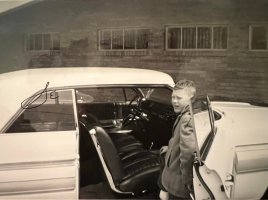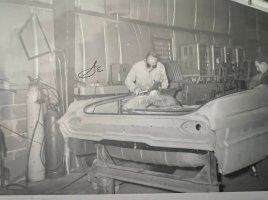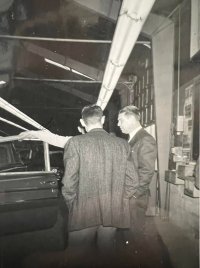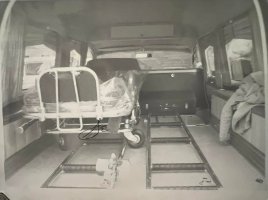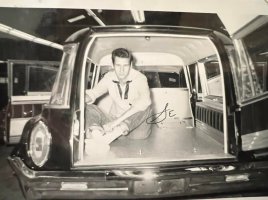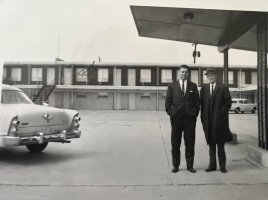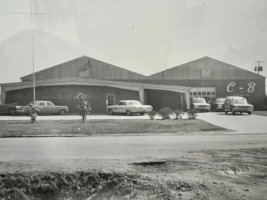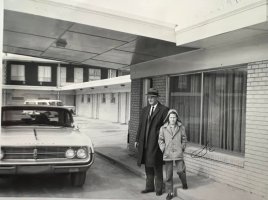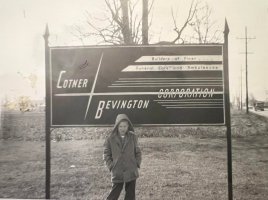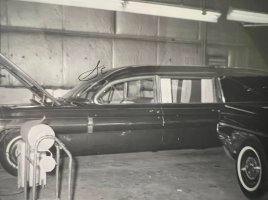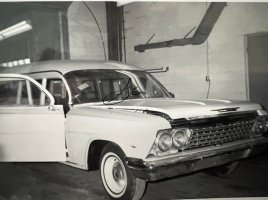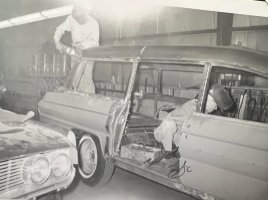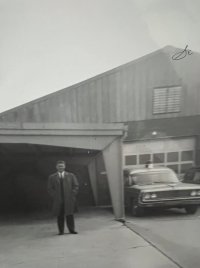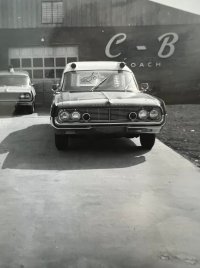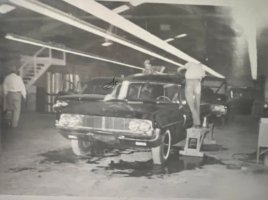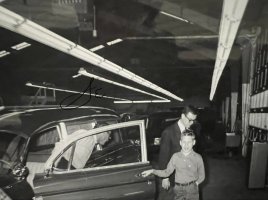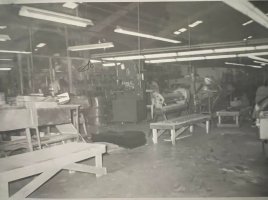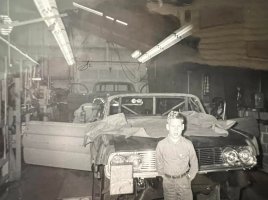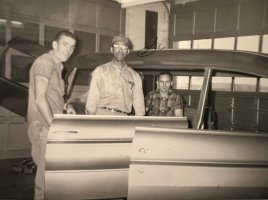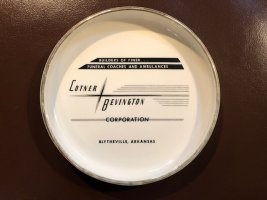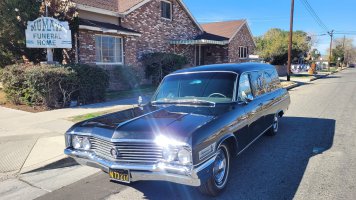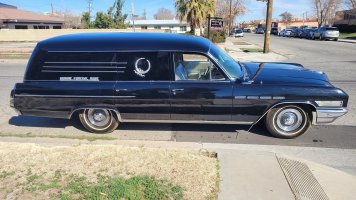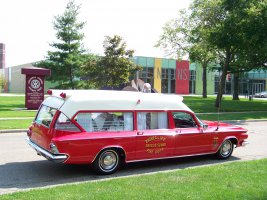You are using an out of date browser. It may not display this or other websites correctly.
You should upgrade or use an alternative browser.
You should upgrade or use an alternative browser.
Early C/B Factory Pics
- Thread starter Daniel Scully
- Start date
Good stuff.
Tim Prieur
PCS Member
Thanks for sharing.
Kurt Arends
PCS Elected Director 2021-2024
Ok, excuse my ignorance. Was C-B starting with Olds 88 sedans? I assume the Starfire hardtop in the first pic did not get dissected. No Olds commercial chassis in the 60s correct?
Almost all the smaller bodybuilders (National, Cotner Bevington, Economy, Pinner, etc.) back in the 1960s would start with a 4 door sedan and then build the car from that platform. The 4 door cars were the staple of the automobile business, and the least expensive cars to purchase. You have to keep in mind that in the 1960s, labor was inexpensive and that the body men were talented. The only "commercial chassis" available was the Cadillac, however, the other GM divisions would make allowances to the build to allow conversions to be done economically. Generally speaking, Ford and Chrysler's products were not used in great numbers, but if that were what the customer wanted, the builders would accommodate the buyer's wishes. I have seen pictures of a few Ford, Edsel, Plymouth, Dodge, Desoto, and Chrysler cars that were modified for ambulance or hearse use.
By the mid to late 1950s, Packard stopped producing cars, and for the most part, only GM, Ford, and Chrysler were left. Names such as Henry J, Kaiser, Hudson, Allstate, etc. were gone also.
By the mid to late 1950s, Packard stopped producing cars, and for the most part, only GM, Ford, and Chrysler were left. Names such as Henry J, Kaiser, Hudson, Allstate, etc. were gone also.
Terry Lange
PCS Member
Going back to '59 when C/B was still Comet Coach, their extended wheelbase Oldsmobiles started out as 2 door sedans.
Abe Bush
PCS Member
The Henney Company in Freeport IL built pro cars almost exclusively on the Packard professional car chassis until 1954, and Packard itself folded shortly after that. The Henney Company briefly considered building on the Cadillac commercial chassis when Packard folded, but they ultimately decided against it, as they didn't want to build "just another Cadillac".
The Flxible Company in Loudonville OH built professional cars mainly on the Buick chassis until the end of the 1964 model year when they exited the professional car building business for the second -- and last -- time. They continued building Flxible buses for many years.
The Eureka Company in Rock Falls IL built only on the Cadillac professional car chassis in their antiquated two-story plant until they went out of business in 1964. Eureka's frames were largely made of wood for many of the years they were in production, and there remained some hand-carved wooden frame components even in its final years. Eureka was known for their high quality (and premium priced offerings), much of their vehicles were built by hand, and their interior appointments and components were made of the highest quality materials, with rich hand finished wooden components and cabinetry. Eureka interiors were, and are to this day considered second-to-none.
The Hess and Eisenhardt Company of Cincinnati OH, builders of S&S professional cars, built exclusively on the Cadillac professional car chassis. S&S professional cars were among the highest priced offerings, but many of their customers were all too willing to pay that premium price for the status and prestige of owning an S&S. They were known to utilize very conservative styling, and their hightop professional ambulances utilized essentially a largely unchanged body from the mid 1950s until S&S ended their professional car portion of the business in 1976. But their parent company -- Hess & Eisenhardt -- is still in business to this day, and is known for building highly specialized armored cars and limousines. In fact, the Hess & Eisenhardt company was responsible for designing and building president John F Kennedy's infamous convertible parade limousine, originated as a 1961 Lincoln, in which he was assassinated on the streets of Dallas TX on November 22, 1963. JFK refused to have the "bubble top" on the car as it made its way to the Trade Mart in Dallas, in a top-down motorcade. While the bubble top was in no way armored, or bullet proof, it may have provided some level of protection as the motorcade wound its way through Dealey Plaza in Dallas. This was the last time a U.S. President was ever allowed to ride in a top-down un-armored car. The famous Lincoln parade limo was eventually brought back to Hess & Eisenhardt headquarters, stripped down to the frame, and re-built from the ground up and completely armored, and a 1963 front clip replaced the original 1961 front. This car was continued to be used for many years to come, and all presidents were known to have used it up through Gerald Ford. The car currently resides in the Henry Ford museum, in Dearborn MI where it is prominently displayed for all museum visitors to see it.
The Superior Coach company of Lima, OH built both Cadillac, and Pontiac Professional Cars. The Cadillacs utilized the Cadillac professional car chassis and were built at Superior's Lima OH facility, and their Pontiacs were built on the Pontiac Bonneville sedan chassis at their Kosciusko MS plant. Superior ended production of their Pontiac pro cars in 1975, and the entire company went out of business in 1980. The U.S. Navy military ambulance that carried president Kennedy's dead body and casket from Andrews Air Force Base to the Bethesda Naval Hospital for autopsy and embalming was a 1963 Superior Pontiac ambulance, built using military specs, and was eventually crushed under orders of Robert Kennedy, who didn't want it to become a morbid curiosity.
The Miller-Meteor division of Wayne Corporation -- previously the Divco-Wayne company when they first acquired Miller, and then Meteor -- a bus manufacturer, built exclusively on the Cadillac professional car chassis until going out of business in 1979, not long after GM dramatically downsized their cars for the 1977 model year. The Miller-Meteor professional cars were ultimately built in the Piqua OH plant after a short stint at the A.J. Miller company's original plant in Bellefontaine OH. One of the more famous Miller-Meteor cars was a 1959 M-M combination car that was used in the 1980s hit movie "Ghostbusters" starring Dan Akroyd and Bill Murray. The car -- known as Ecto 1 -- has been recently restored back to production quality, and admired by Dan Akroyd who came to view the restoration, and reminisce. The Cotner-Bevington division of Wayne Works in Blytheville AR -- originally the Comet Coach company until Ford bought the Comet name -- built mainly on the Oldsmobile Ninety-Eight sedan chassis until they closed in 1975. An early 70s C/B (Oldsmobile) hightop ambulance was featured in the 1976 movie "Mother Jugs & Speed", and was operated by the fictious Unity Ambulance Service in which their rival company, "F+B", competed against them and jumped each other's ambulance calls often. Cotner Bevington also built a limited number of Chevy professional cars on the Chevy passenger car chassis, of which PCS President Paul Steinberg owns a 1962 Cotner Bevington Chevy ambulance built on a passenger car chassis.
There were a Hodge-Podge of smaller, less known builders as well, like Pinner Coach, National, Siebert etc, many of which would build on any chassis the customer requested.
The Flxible Company in Loudonville OH built professional cars mainly on the Buick chassis until the end of the 1964 model year when they exited the professional car building business for the second -- and last -- time. They continued building Flxible buses for many years.
The Eureka Company in Rock Falls IL built only on the Cadillac professional car chassis in their antiquated two-story plant until they went out of business in 1964. Eureka's frames were largely made of wood for many of the years they were in production, and there remained some hand-carved wooden frame components even in its final years. Eureka was known for their high quality (and premium priced offerings), much of their vehicles were built by hand, and their interior appointments and components were made of the highest quality materials, with rich hand finished wooden components and cabinetry. Eureka interiors were, and are to this day considered second-to-none.
The Hess and Eisenhardt Company of Cincinnati OH, builders of S&S professional cars, built exclusively on the Cadillac professional car chassis. S&S professional cars were among the highest priced offerings, but many of their customers were all too willing to pay that premium price for the status and prestige of owning an S&S. They were known to utilize very conservative styling, and their hightop professional ambulances utilized essentially a largely unchanged body from the mid 1950s until S&S ended their professional car portion of the business in 1976. But their parent company -- Hess & Eisenhardt -- is still in business to this day, and is known for building highly specialized armored cars and limousines. In fact, the Hess & Eisenhardt company was responsible for designing and building president John F Kennedy's infamous convertible parade limousine, originated as a 1961 Lincoln, in which he was assassinated on the streets of Dallas TX on November 22, 1963. JFK refused to have the "bubble top" on the car as it made its way to the Trade Mart in Dallas, in a top-down motorcade. While the bubble top was in no way armored, or bullet proof, it may have provided some level of protection as the motorcade wound its way through Dealey Plaza in Dallas. This was the last time a U.S. President was ever allowed to ride in a top-down un-armored car. The famous Lincoln parade limo was eventually brought back to Hess & Eisenhardt headquarters, stripped down to the frame, and re-built from the ground up and completely armored, and a 1963 front clip replaced the original 1961 front. This car was continued to be used for many years to come, and all presidents were known to have used it up through Gerald Ford. The car currently resides in the Henry Ford museum, in Dearborn MI where it is prominently displayed for all museum visitors to see it.
The Superior Coach company of Lima, OH built both Cadillac, and Pontiac Professional Cars. The Cadillacs utilized the Cadillac professional car chassis and were built at Superior's Lima OH facility, and their Pontiacs were built on the Pontiac Bonneville sedan chassis at their Kosciusko MS plant. Superior ended production of their Pontiac pro cars in 1975, and the entire company went out of business in 1980. The U.S. Navy military ambulance that carried president Kennedy's dead body and casket from Andrews Air Force Base to the Bethesda Naval Hospital for autopsy and embalming was a 1963 Superior Pontiac ambulance, built using military specs, and was eventually crushed under orders of Robert Kennedy, who didn't want it to become a morbid curiosity.
The Miller-Meteor division of Wayne Corporation -- previously the Divco-Wayne company when they first acquired Miller, and then Meteor -- a bus manufacturer, built exclusively on the Cadillac professional car chassis until going out of business in 1979, not long after GM dramatically downsized their cars for the 1977 model year. The Miller-Meteor professional cars were ultimately built in the Piqua OH plant after a short stint at the A.J. Miller company's original plant in Bellefontaine OH. One of the more famous Miller-Meteor cars was a 1959 M-M combination car that was used in the 1980s hit movie "Ghostbusters" starring Dan Akroyd and Bill Murray. The car -- known as Ecto 1 -- has been recently restored back to production quality, and admired by Dan Akroyd who came to view the restoration, and reminisce. The Cotner-Bevington division of Wayne Works in Blytheville AR -- originally the Comet Coach company until Ford bought the Comet name -- built mainly on the Oldsmobile Ninety-Eight sedan chassis until they closed in 1975. An early 70s C/B (Oldsmobile) hightop ambulance was featured in the 1976 movie "Mother Jugs & Speed", and was operated by the fictious Unity Ambulance Service in which their rival company, "F+B", competed against them and jumped each other's ambulance calls often. Cotner Bevington also built a limited number of Chevy professional cars on the Chevy passenger car chassis, of which PCS President Paul Steinberg owns a 1962 Cotner Bevington Chevy ambulance built on a passenger car chassis.
There were a Hodge-Podge of smaller, less known builders as well, like Pinner Coach, National, Siebert etc, many of which would build on any chassis the customer requested.
Abe the keywords are almost exclusively. The flagship across the line was the Cadillac commercial chassis. It was all so the only chassis availabile. Packard had dropped out in the mid-50s. But across the lineup, you will find an example of a large body car converted into a Hearse, Ambulance, or first-call built on every car out there. Once built it's all most impossible to determine which trim level they started with. Remember the only difference in the big bodies was trim. Corporations operated on the bottom line back then also. The big three sourced out parts. These sources would willingly sell runs of parts to anyone with an order large enough to be worth tooling up for. That's how you get the identically shaped moldings in different sizes across the lines of different builders. The smaller builders were the only ones that would start with a complete car. As The big three were also invested in maintaining control of their brand. They kept a lock on selling incomplete bodies to only a few. That left the smaller builders buying complete cars to convert, raising their costs. Most of them had a dealer they worked with to get their cars as cheap as they could. Also buy parts threw at cheaper than the market price. To give their customers the options they wanted. So it is impossible to say what the base car anyone builder started out with if you don't take it apart. Then if it's not the Caddy chassis any two cars from a smaller builder could be a different body to start with. You strip one down to the shell you see a lot of things.
I love learning these things. I am a hardcore Kaiser Frazer guy but I have always been fascinated with coach built hearses and passenger car based ambulances. The talent back then, especially given the tools, was amazing
Abe Bush
PCS Member
Ed, are you saying that Superior Pontiacs didn't always start with a Bonneville, and Cotner Bevington Oldsmobiles didn't always start with a 98? I think that every Superior Pontiac I've seen was always Bonneville branded on the exterior and interior, and I've never seen a C/B Oldsmobile with Delta/Dynamic 88 tail lights or front cowls. Although admittedly the front of both brands looked very similar -- if not identical -- to their lower priced siblings. AND, in the late 60s through the very early 70s the Superior Pontiacs utilized what appeared to be their own tail lights rather than using stock Bonneville/big Pontiac tail lights. I've also noticed that both Pontiac Consorts and Oldsmobile Sevilles appeared to use stock rear/side doors from either a sedan, or a station wagon, or perhaps there was no difference between the two.Abe the keywords are almost exclusively. The flagship across the line was the Cadillac commercial chassis. It was all so the only chassis availabile. Packard had dropped out in the mid-50s. But across the lineup, you will find an example of a large body car converted into a Hearse, Ambulance, or first-call built on every car out there. Once built it's all most impossible to determine which trim level they started with. Remember the only difference in the big bodies was trim. Corporations operated on the bottom line back then also. The big three sourced out parts. These sources would willingly sell runs of parts to anyone with an order large enough to be worth tooling up for. That's how you get the identically shaped moldings in different sizes across the lines of different builders. The smaller builders were the only ones that would start with a complete car. As The big three were also invested in maintaining control of their brand. They kept a lock on selling incomplete bodies to only a few. That left the smaller builders buying complete cars to convert, raising their costs. Most of them had a dealer they worked with to get their cars as cheap as they could. Also buy parts threw at cheaper than the market price. To give their customers the options they wanted. So it is impossible to say what the base car anyone builder started out with if you don't take it apart. Then if it's not the Caddy chassis any two cars from a smaller builder could be a different body to start with. You strip one down to the shell you see a lot of things.
No, I did not state that CB after the Indian head corporation take over was not built exclusively on an incompletely 98 4-door sedan chassis. Or the superior Pontiacs were not built on Bonnies. The larger corporations had locks on brand names. With exclusive contracts. S&S built Cadillacs and convertibles for GM. But to say any of the small companies used this body to build theirs that because it had a long front door it was built off a e door sedan would only be determined by the serial number of the body if it even had one from the original manufacture still on it. When you are cutting a car in two add a roof and a whole rear body. You could start with a 4-door and add the 2-door doors if you wanted to have a long door. Those of us that got to visit with Tom and Jack Pinner got a lot of good insight into how the smaller builders would do things. Combinations of new and used parts of different rigs to get the desired effect. But to say that Superior built exclusively on Bonnevilles for their Pontiac line might not be true. What was different in the sheet steel between the full-size cars. Trim? All that superior was using was the front end from a full-size Pontiac trimmed with Bonnie trim. The whole rest of the car was built by them. But you do know it was cost driven. Labor cost also. So the only thing you can be sure of is they used whatever was cheapest to get the max profit. Just like GM was. The smaller builders did the same. The one thing I do know is there are no absolutes with these cars.
Philip Scanio
PCS Member / Super Site Supporter
My 1986 AHA Lincoln 54 inch stretched VIP limo had Volkswagen back windows for the stretch glass.
Kurt Arends
PCS Elected Director 2021-2024
It is really interesting to study these builds, even with the major builders. My '64 Superior Pontiac ambulance is badged as a Bonneville, but all of the lower body side moldings are Star Chief, not Bonneville. It is a mix of Bonneville & Star Chief. All '71-'75 Superior Pontiac coaches have Catalina quarter panels, but are badged as Bonnevilles.


